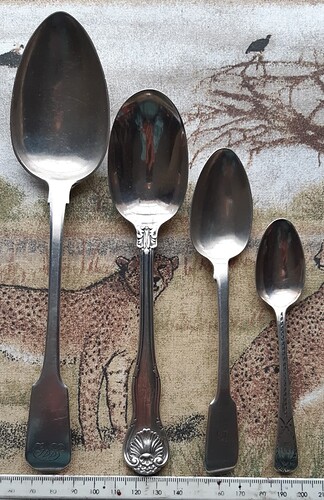Good day, friends. I am providing a picture of four antique sterling silver spoons of varying lengths. From left to right they measure 22,0 cm, 18,1 cm, 16,0 cm and 12,5 cm.
I know the left one to be a table spoon. The one of the right is a teaspoon.
The one next to the teaspoon is dessert spoon.
So what do we call the one next to the tablespoon?
Please be so kind as to give me a clue. The question has me perplexed!
Regards
Jan
Dessert spoons can be 16-18 cm long so I suggest that both the 16 and 18.1 cm spoons are dessert spoons. Note that they are of different patterns (and maybe also from slightly different eras?) so we shouldn’t necessarily expect uniformity of size. I guess each manufacturer would have had their own size standards which would have varied with differing fashions.
So I think your 18.1cm spoon is a large dessert spoon.
Phil
Phil, thank you for clearing that up for me. The way I try to organize my small collection is that I start each entry in my record-keeping system with the “type” of spoon. For that I needed reliable type categories, which thus far caused me more than a little confusion. Your help is much appreciated.
Regards
Jan
Phil, noting the question mark in your reply, I thought you and other readers might like to know how the four spoons in the picture “identify”?
From left:
The first one is a fiddle pattern Cape silver tablespoon, made by Carel David Lotter of Cape Town, South Africa, active between 1812 to 1848. I suspect the purity is sterling, as he probably used the British coinage of the time.
The second one, as you said, is a larger than normal dessert spoon of the King’s pattern, made by George William Adams, London, in 1859.
Third is a dessert spoon (fiddle pattern) made by John Smyth of Dublin. Also present is the mark of the retailer Neill. Dated 1846, the worst year of the great potato blight in Ireland!.
Lastly there’s the teaspoon, pattern not yet identified, made by Peter and Ann Bateman in 1795.
What a great hobby we have, don’t you agree!
Regards
Jan
These French guides from Christofle and Odiot have flatware shapes and sizes. I find them very handy.
Christofle
https://www.christofle.com/us_en/services/size-guide/cutlery
Odiot
Sent from my iPhone
Jose
Jose, thank you for those guides! I started looking at them and they do seem handy to give me a good size classification.
Friends, this smallest of the four spoons in the top pic is really one of my favourites. See the two pics below. Marked by the sponsor Peter & Ann Bateman, and assayed 1795, but with the assay office mark clearly lacking. Of course, we realise the sponsor is a London silversmith.
But here’s the thing: I imagine the attractive design was cut in by hand, by one of the business’ craftsmen. Surely there’s no other way it could have been put on the spoon! Would I be correct in this assumption? And the pattern? How can we describe this pattern? Please help me out.
Regards
Jan
awesome thank you for that
Jan, I have a few Peter and Ann Bateman pieces that are similar in style and I’m also unsure how to describe them.


